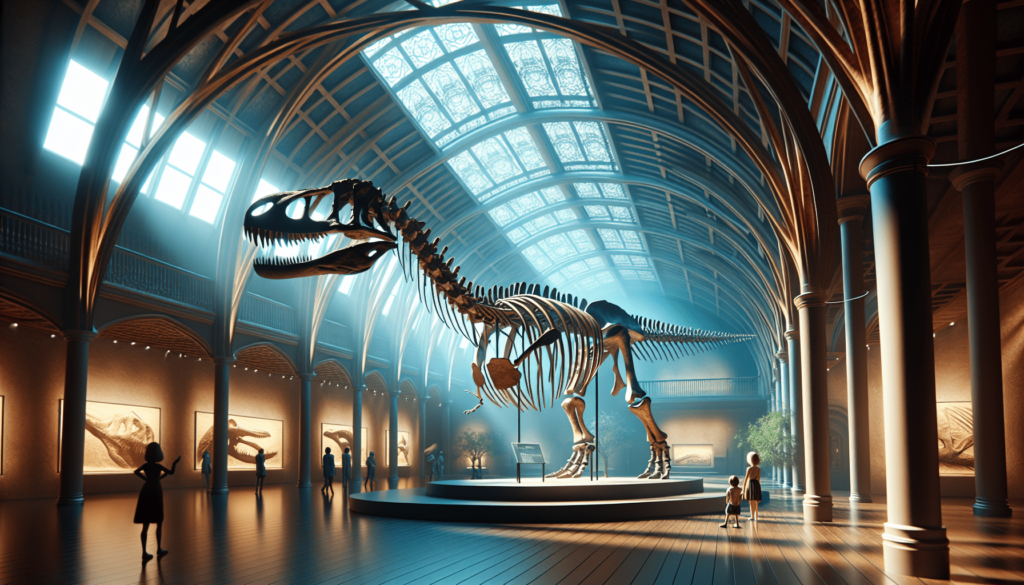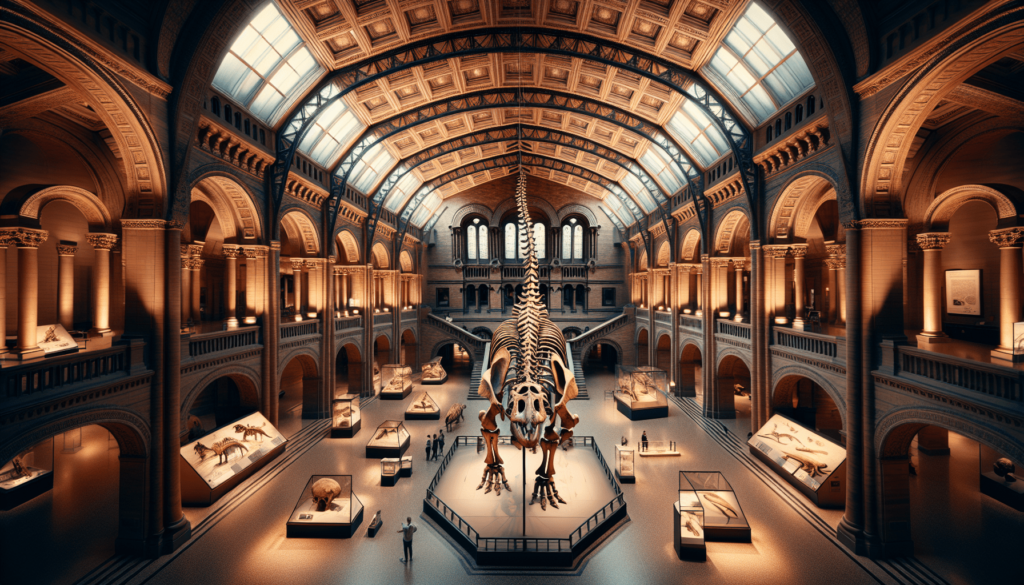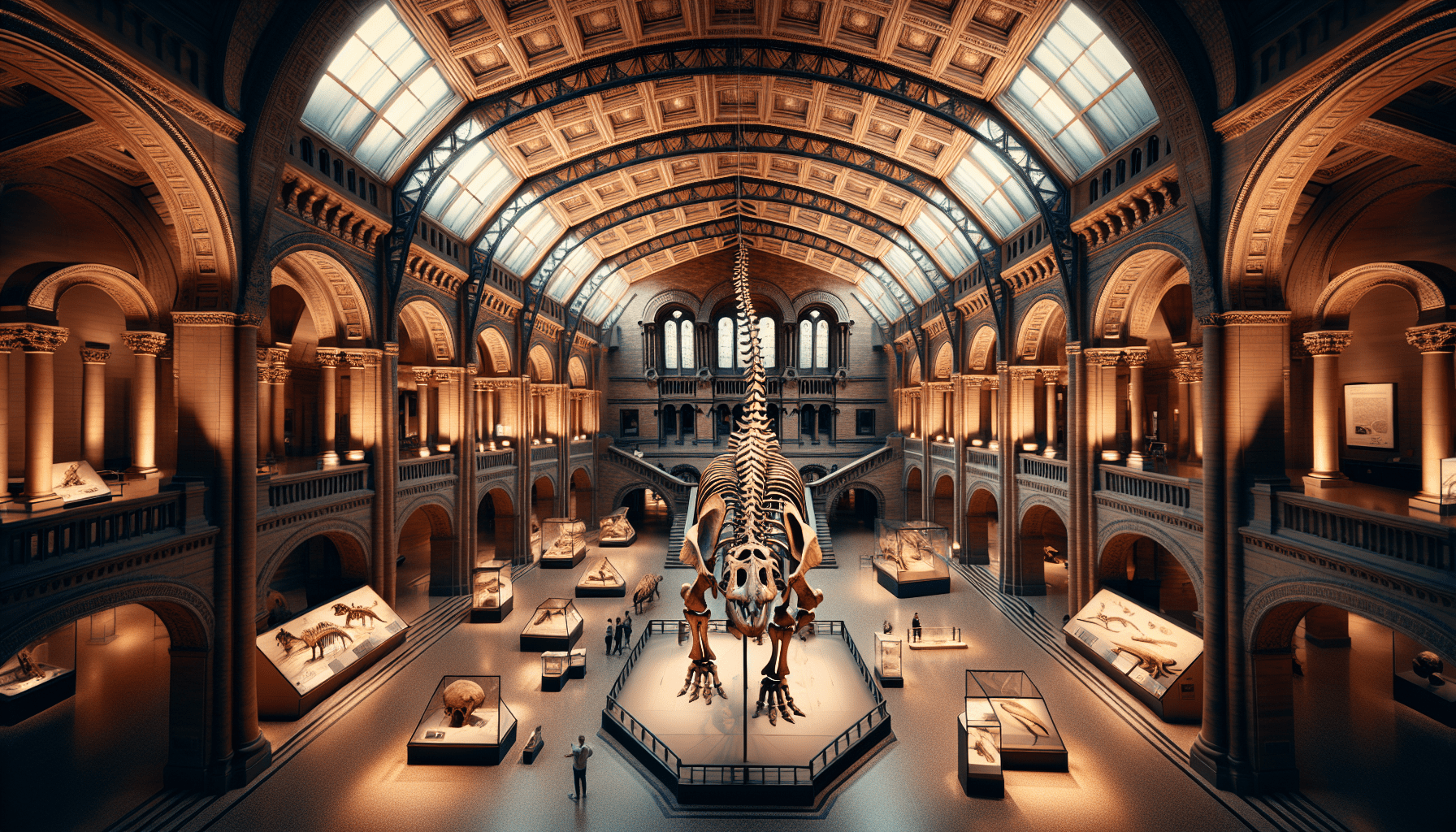Located in the heart of New York City, the American Museum of Natural History stands as a fascinating testament to the natural wonders of our world. With a rich history dating back to 1869, this iconic institution has become an essential destination for those seeking to delve into the depths of human knowledge and understanding. Boasting an extensive collection of over 34 million specimens ranging from dinosaur fossils to intricate dioramas showcasing ecosystems from around the globe, the museum offers visitors a truly immersive experience. As we explore the hallowed halls and marvel at the intricacies of the universe, we are transported on a journey of discovery and awe. Join us as we embark on an exploration of the American Museum of Natural History, where the wonders of our planet and beyond await.
About the American Museum of Natural History
Overview
The American Museum of Natural History, located in New York City, is one of the largest and most prestigious natural history museums in the world. It was founded in 1869 and has since become a renowned institution for scientific research, education, and public outreach. The museum is home to an extensive collection of artifacts and specimens, spanning a wide range of disciplines including paleontology, anthropology, astronomy, and biodiversity. With its impressive exhibitions, educational programs, and research facilities, the American Museum of Natural History offers visitors a unique opportunity to explore the wonders of the natural world.
History
The history of the American Museum of Natural History dates back to its establishment in 1869 by a group of prominent scientists, educators, and businessmen. Led by Albert Smith Bickmore and supported by leading figures such as Theodore Roosevelt Sr., the museum was initially formed with the goal of promoting science and education. Over the years, it has grown exponentially, expanding its collections, research capabilities, and public outreach. Today, the museum stands as a testament to more than a century of scientific discovery and exploration.
Mission
The mission of the American Museum of Natural History is to discover, interpret, and disseminate knowledge about human cultures and the natural world through its scientific research, exhibitions, educational programs, and publications. By fostering a deep understanding of the diversity and interconnectedness of all life forms, the museum aims to inspire curiosity, promote scientific literacy, and encourage stewardship of the planet. Through its research and collections, the museum also strives to contribute to the advancement of scientific knowledge across various fields.
Exhibitions at the Museum
Permanent Exhibitions
The American Museum of Natural History is home to a wide array of permanent exhibitions that cover a broad range of scientific disciplines. One of the most iconic exhibits is the Dinosaur Hall, which features an awe-inspiring collection of dinosaur fossils, including the beloved Tyrannosaurus Rex and Triceratops specimens. The museum also showcases the Hall of Human Origins, which explores the evolution of humans and the rich diversity of human cultures. Other permanent exhibitions include the Hall of Biodiversity, the Rose Center for Earth and Space, and the Akeley Hall of African Mammals, providing visitors with immersive and educational experiences across various scientific fields.
Temporary Exhibitions
In addition to its permanent exhibitions, the American Museum of Natural History hosts a rotating selection of temporary exhibitions. These exhibits feature a range of topics, from the natural wonders of specific regions to cutting-edge scientific discoveries and innovations. Temporary exhibitions allow the museum to continuously bring fresh and engaging content to its visitors, ensuring that there is always something new to discover and learn. With a diverse lineup of temporary exhibits, the American Museum of Natural History offers a dynamic and ever-evolving experience for visitors of all ages.
Special Exhibitions
Alongside its permanent and temporary exhibits, the American Museum of Natural History also presents special exhibitions that delve into specific themes or phenomena. These special exhibitions often showcase a combination of scientific research and artistic interpretation, providing a unique and multifaceted perspective on the subject at hand. From exploring the wonders of the deep sea to unraveling the mysteries of outer space, these special exhibits offer visitors a deeper understanding and appreciation of the natural world and the scientific inquiries that shape our knowledge.

Looking for Sightseeing Tours?
Dinosaur Fossils and Paleontology
Dinosaur Hall
One of the most popular attractions at the American Museum of Natural History is the Dinosaur Hall, which transports visitors back in time to the age of dinosaurs. This expansive exhibit showcases a remarkable collection of real dinosaur fossils, including the iconic Tyrannosaurus Rex and Triceratops skeletons. Visitors can marvel at the massive size and intricate details of these ancient creatures, gaining a deeper understanding of their anatomy, behavior, and evolutionary significance. The Dinosaur Hall offers a captivating experience for both children and adults, igniting a sense of wonder and awe at the diversity and grandeur of prehistoric life.
Tyrannosaurus Rex Exhibit
Within the Dinosaur Hall, the American Museum of Natural History houses an impressive exhibit dedicated to the Tyrannosaurus Rex, one of the most famous and fearsome dinosaurs to have ever existed. This exhibit provides a comprehensive look at the biology and lifestyle of the T. Rex, featuring a range of specimens, interactive displays, and informative panels. Visitors can learn about the incredible hunting abilities, enormous size, and intricate evolutionary adaptations of this apex predator. The Tyrannosaurus Rex exhibit offers a captivating experience that allows visitors to truly appreciate the immense power and impact of these ancient creatures.
Triceratops Exhibit
In addition to the Tyrannosaurus Rex exhibit, the American Museum of Natural History also showcases a dedicated exhibit exploring the Triceratops, a distinctive and awe-inspiring dinosaur known for its horns and frill. This exhibit offers visitors the opportunity to study the anatomy and behavior of Triceratops specimens through a combination of fossils, detailed reconstructions, and interactive displays. Visitors can gain a deeper understanding of this herbivorous dinosaur’s unique adaptations and its interactions within the ecosystems of the Cretaceous period. The Triceratops exhibit provides a fascinating glimpse into the natural history and evolutionary diversity of the prehistoric world.
Paleontology Research
Behind the scenes at the American Museum of Natural History, a team of dedicated paleontologists and researchers are actively engaged in the study of fossils and the field of paleontology. The museum conducts extensive scientific research on topics ranging from dinosaur evolution to the reconstruction of ancient ecosystems. Through field expeditions, laboratory analyses, and collaborative efforts with international institutions, researchers at the American Museum of Natural History contribute to the advancement of paleontological knowledge and the understanding of Earth’s history. The museum’s commitment to paleontology research ensures a constant stream of new discoveries and insights into the ancient world.
Meteorites and Space Exploration
Rose Center for Earth and Space
At the heart of the American Museum of Natural History stands the Rose Center for Earth and Space, a breathtaking architectural masterpiece that houses the museum’s celestial exhibits. The centerpiece of the Rose Center is the Hayden Planetarium, which offers visitors a captivating journey through the cosmos. Through state-of-the-art audiovisual technology, visitors can explore the wonders of the universe, from distant galaxies to our own solar system. The Rose Center provides a unique and immersive experience that intertwines scientific discovery, space exploration, and a sense of wonder at the vastness and complexity of the universe.
Hall of Meteorites
Within the Rose Center, the Hall of Meteorites showcases a stunning collection of meteorite specimens, offering visitors a glimpse into the extraterrestrial materials that have fallen to Earth. The exhibit provides a comprehensive overview of meteorites, their origins, and their scientific significance. Visitors can marvel at meteorites from various locations around the world, ranging from small fragments to massive iron meteorites. The Hall of Meteorites allows visitors to appreciate the power of cosmic events and their role in shaping our planet’s geological history.
Astrophysics and Cosmology
Beyond the Hall of Meteorites, the American Museum of Natural History offers a range of exhibits and programs dedicated to astrophysics and cosmology. Visitors can explore the latest discoveries in the field of astronomy, from the study of galaxies and black holes to the search for habitable planets in distant star systems. Through interactive displays, multimedia presentations, and informative panels, visitors can gain a deeper understanding of the fundamental processes that govern the universe. The museum’s astrophysics and cosmology exhibits provide a captivating exploration of the mysteries and wonders of the cosmos.

Looking for Sightseeing Packages?
Human Origins and Anthropology
Hall of Human Origins
The Hall of Human Origins at the American Museum of Natural History delves into the fascinating story of human evolution and the development of human societies. This exhibit takes visitors on a journey through time, tracing the origins of early humans and exploring the remarkable adaptations that have allowed our species to thrive. Through a combination of fossils, reconstructions, and interactive displays, visitors can gain a deeper understanding of the biological, cultural, and technological milestones that have shaped human history. The Hall of Human Origins offers a thought-provoking exploration of the diversity and interconnectedness of human life.
Cultural Halls
In addition to the Hall of Human Origins, the American Museum of Natural History features a series of cultural halls that celebrate the rich diversity of human cultures across the globe. These exhibits showcase artifacts, artwork, and traditional objects from various regions and time periods, providing a comprehensive look at the cultural heritage of different societies. Visitors can explore the rituals, customs, and artistic expressions of ancient civilizations, gaining insights into the similarities and differences that shape human experiences. The cultural halls offer a window into the multifaceted tapestry of human culture throughout history.
Anthropology Research
Behind the exhibits at the American Museum of Natural History, a team of anthropologists and researchers are actively engaged in the study of human societies and cultures. The museum conducts extensive research in the field of anthropology, both within its collections and through collaboration with indigenous communities and international partners. Through ethnographic studies, linguistic analyses, and archival research, anthropologists at the American Museum of Natural History strive to deepen our understanding of human cultural diversity, foster cultural appreciation, and contribute to the preservation of endangered traditions. The museum’s anthropology research serves as a bridge between past and present, connecting visitors with the rich tapestry of human experiences.
Biodiversity and Animal Exhibits
Hall of Biodiversity
The Hall of Biodiversity at the American Museum of Natural History celebrates the intricate web of life on Earth, showcasing the incredible diversity of species and ecosystems. Through immersive exhibits and interactive displays, visitors can explore the various biomes of the world, from rainforests to coral reefs. The hall highlights the interconnectedness of all living organisms and the ecological processes that sustain life. Visitors can learn about the urgent need for biodiversity conservation and gain a deeper appreciation for the intricate balance that exists within our planet’s ecosystems.
Akeley Hall of African Mammals
One of the museum’s most iconic exhibits is the Akeley Hall of African Mammals, named after Carl Akeley, a renowned taxidermist and conservationist. This exhibit features a spectacular display of dioramas showcasing the diverse wildlife found in the African continent. From elephants and lions to giraffes and zebras, visitors can admire the lifelike representations of these majestic creatures in their natural habitats. The Akeley Hall of African Mammals not only provides an immersive experience for visitors, but also promotes awareness and conservation of African wildlife.
North American Mammals
In addition to the Akeley Hall of African Mammals, the American Museum of Natural History also hosts an exhibit dedicated to the diverse mammalian fauna of North America. Through dioramas, specimens, and interactive displays, visitors can explore the ecosystems and animal life found in this region. From the grizzly bears of the Rocky Mountains to the bison herds of the Great Plains, the exhibit offers a comprehensive look at the unique adaptations and ecological relationships of North American mammals. Visitors can gain a deeper understanding of the importance of conserving these species and their habitats.
Marine Life
The American Museum of Natural History is not only focused on terrestrial life, but also offers captivating exhibits dedicated to marine life. Visitors can explore the wonders of the ocean through exhibits that showcase various marine ecosystems, from coral reefs to deep-sea trenches. The museum boasts an impressive collection of marine specimens, including preserved fish, coral specimens, and a life-sized replica of a blue whale. Through interactive displays and informative panels, visitors can learn about the ecological importance of marine environments, the challenges they face, and the ongoing efforts to protect these fragile ecosystems.
Insect Zoo
At the American Museum of Natural History, visitors can dive into the miniature world of insects through the Insect Zoo, an exhibit dedicated to the fascinating and often misunderstood realm of bugs. This interactive exhibit allows visitors to get up close and personal with live insects, learning about their biology, behavior, and ecological roles. From beetles and butterflies to spiders and scorpions, the Insect Zoo showcases the incredible diversity and adaptations of these small yet essential creatures. The exhibit also highlights the importance of insects in maintaining the balance of ecosystems and the ongoing research to better understand and protect them.
Need to Find Attractions and Offers?
Museum Learning and Educational Programs
School Field Trips
The American Museum of Natural History offers a variety of educational programs designed specifically for school field trips. These programs provide students with the opportunity to explore the museum’s exhibits, engage in hands-on activities, and participate in interactive workshops led by experienced educators. Through guided tours and curriculum-aligned programs, students can deepen their understanding of scientific concepts, develop critical thinking skills, and foster a sense of curiosity and wonder about the natural world. School field trips to the American Museum of Natural History provide students with a unique and enriching learning experience that complements classroom instruction.
Educator Resources
In addition to school field trips, the American Museum of Natural History provides a wealth of resources and support for educators. The museum offers professional development workshops, curriculum guides, and online resources that help teachers integrate museum exhibits and content into their classroom instruction. Educators can access lesson plans, activity ideas, and multimedia materials that align with state and national educational standards. The museum’s educator resources aim to enhance science education, promote inquiry-based learning, and empower educators to inspire their students through engaging and meaningful scientific experiences.
Family Programs
The American Museum of Natural History welcomes families to explore its exhibits and participate in a wide range of family-friendly programs. These programs offer hands-on activities, demonstrations, and interactive experiences that engage children and adults alike. From science festivals to family sleepovers, the museum provides opportunities for families to bond over shared discoveries and learn together. Family programs at the American Museum of Natural History foster a love for science, encourage exploration, and spark the next generation’s curiosity about the natural world.
After-Hours Events
For those seeking a unique and memorable experience, the American Museum of Natural History hosts a series of after-hours events throughout the year. These events allow visitors to explore the museum’s exhibits in a more intimate setting, away from the usual crowds. From exclusive tours to special presentations and performances, after-hours events offer a captivating blend of entertainment and education. Whether it’s a themed party or an evening of stargazing, these events provide a one-of-a-kind opportunity to engage with the museum’s exhibits and collections in a unique and immersive way.
The Museum’s Research and Collections
Research Centers
The American Museum of Natural History houses several research centers that focus on different scientific disciplines. These centers serve as hubs for scientific inquiry, allowing researchers to conduct cutting-edge studies and collaborate with both national and international partners. From the Center for Biodiversity and Conservation to the Sackler Institute for Comparative Genomics, the museum’s research centers work on a broad range of topics, including evolutionary biology, cultural anthropology, and astrophysics. Through their research, the museum’s scientists contribute to the advancement of scientific knowledge and shape our understanding of the natural world.
Collections and Archives
At the core of the American Museum of Natural History’s research efforts are its extensive collections and archives. The museum boasts a vast assemblage of specimens, artifacts, and objects from around the world, ranging from dinosaur fossils and cultural artifacts to meteorites and botanical specimens. These collections, carefully curated and preserved by a team of experts, serve as important resources for both scientific research and public education. Researchers can access these collections to study biodiversity, trace the evolutionary history of species, and explore the cultural heritage of different societies. The museum’s collections and archives are a treasure trove of knowledge, providing an invaluable source of information to scientists and scholars.
Library Resources
In addition to its collections and archives, the American Museum of Natural History maintains a comprehensive library that supports research and scholarship in the natural sciences. The library houses a vast collection of books, journals, and digital resources, spanning a wide range of disciplines, including paleontology, anthropology, and astronomy. Researchers, students, and the general public can access these materials to delve deeper into specific topics, conduct literature reviews, and stay up to date with the latest scientific publications. The museum’s library resources serve as a valuable tool for both academic research and personal enrichment.
Facilities and Amenities
Museum Shop
The American Museum of Natural History offers a diverse array of merchandise at its museum shop, allowing visitors to bring home a piece of their museum experience. From scientific toys and educational books to unique jewelry and clothing, the shop provides a wide range of products that cater to different interests and age groups. The museum shop also supports the museum’s mission, as a portion of the proceeds goes towards supporting educational programs, research initiatives, and conservation efforts. Whether visitors are looking for a memento or a gift, the museum shop offers a selection of high-quality products that inspire curiosity and celebrate the wonders of the natural world.
Food and Dining Options
For those looking to recharge during their visit, the American Museum of Natural History provides a variety of food and dining options. The museum houses several cafes and restaurants that offer a range of culinary choices, from casual bites to full meals. Visitors can enjoy a quick snack, a cup of coffee, or a leisurely meal amidst the museum’s vibrant atmosphere. The food and dining options at the American Museum of Natural History cater to different tastes and dietary preferences, ensuring that visitors can refuel and continue their exploration with a satisfied palate.
Accessibility Services
The American Museum of Natural History is committed to providing a welcoming and inclusive environment for all visitors. The museum offers a range of accessibility services to ensure that individuals with disabilities can fully enjoy and participate in their museum experience. These services include wheelchair accessibility, captioning and audio description for exhibits, assistive listening devices, and accessible restrooms. The museum continuously works towards removing barriers and improving accessibility throughout its facilities, making it a place that is accessible to everyone.
Membership Benefits
For those who wish to delve deeper into the offerings of the American Museum of Natural History, becoming a member provides an array of benefits. Members receive unlimited free admission to the museum’s exhibits, exclusive access to members-only events, discounts on special exhibitions, and priority access to programs and workshops. Members also enjoy various additional perks, such as discounts at the museum shop and invitations to behind-the-scenes tours and lectures. Becoming a member of the American Museum of Natural History not only grants individuals and families access to the museum’s offerings, but also supports its mission of scientific research, education, and conservation.
Visiting Information
Location and Directions
The American Museum of Natural History is located at Central Park West and 79th Street, in the Upper West Side of Manhattan, New York City. The museum is easily accessible by public transportation, with several subway and bus lines stopping nearby. Visitors can also reach the museum by car, although parking in the area may be limited. Detailed directions and transportation options can be found on the museum’s website or by contacting their visitor services.
Hours of Operation
The American Museum of Natural History is open to the public seven days a week, with the exception of certain holidays. The museum’s regular hours of operation are from 10:00 am to 5:45 pm, but closing time for specific exhibits and attractions may vary. Visitors are advised to check the museum’s website or contact their visitor services for the most up-to-date information on operating hours and any changes or closures.
Admission Fees
Admission to the American Museum of Natural History is ticketed, and prices vary depending on age, residency, and specific exhibitions. General admission tickets grant access to the museum’s permanent exhibits, while additional fees may apply for temporary exhibits, special events, and programs. The museum offers discounted rates for seniors, students, and children. Members of the museum receive free admission and other benefits. Visitors can purchase tickets in advance online, at the museum’s ticket counter, or through authorized ticket vendors.
Tips for Visitors
To make the most of their visit to the American Museum of Natural History, visitors are advised to plan ahead and follow these tips:
- Check the museum’s website or contact visitor services before your visit to ensure you have the most up-to-date information on exhibits, hours, and special programs.
- Consider purchasing tickets in advance to avoid long lines at the ticket counter, especially during peak visitor times.
- Wear comfortable shoes and clothing, as the museum’s exhibits cover a vast space, and visitors can expect to do a fair amount of walking.
- Bring a camera or smartphone to capture memories and document interesting exhibits.
- Consider bringing a refillable water bottle, as there are water fountains available throughout the museum.
- Respect the museum’s guidelines and rules, such as not touching artifacts or specimens and maintaining a quiet and respectful attitude in exhibition areas.
- Take advantage of the museum’s educational resources, such as guided tours and interactive displays, to enhance your understanding of the exhibits.
- Enjoy the experience and take your time exploring the museum’s diverse offerings. With so much to see and learn, allow ample time to fully immerse yourself in the wonders of the natural world.
In conclusion, the American Museum of Natural History stands as a beacon of scientific discovery, education, and public engagement. Through its extensive collections, captivating exhibits, and research initiatives, the museum offers visitors a unique opportunity to explore the wonders of the natural world and delve into the depths of scientific knowledge. From the awe-inspiring dinosaur fossils to the mind-boggling scale of the universe, the American Museum of Natural History provides a captivating and educational experience for visitors of all ages. Whether you are a student, a researcher, a family, or a curious traveler, a visit to this iconic institution is sure to ignite your curiosity, deepen your understanding of the natural world, and leave you with a sense of wonder and admiration for the beauty and complexity of our planet and the universe at large.








